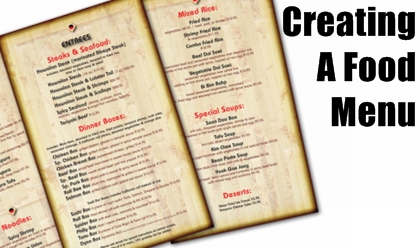If you want to sell food at your pub creating a food menu is one of your chef’s or your most important jobs. Your food menu is usually the main means of selling food to your customers and it is the document that directs and controls the operation of your kitchen. Your menu should make customers want to buy your food and let them know what and when food is available.
Your food menu will dictate what ingredients you buy, the cost of each menu item and the staff and kitchen kit you will need to cook the food. Conversely the style of operation (casual or value dining, gastro pub or pub restaurant) and size of kitchen/staff skills/kitchen kit will determine the menu you can produce.
There are several factors you will need to consider when planning your menu the first should be your Unique Selling Proposition(s) (USP). What will you provide that will mark you out in the crowd of other food retailers (for more guidance see my article on USPs).
Next, what is your marketplace, is your pub in an affluent area that demands fine dining or are you catering for local trade from the industrial park down the road? Do your customers want quick service and value for money or are they going to linger over a three course meal served at a leisurely pace?
How much do you think your customers will be willing to pay for your food? Consider how much you want to try and achieve on a spend per head basis.
Are your customers conscious of food miles (locally sourced food) and do they want seasonal food? Are they concerned about food provenance such as Red Tractor or Farm Assured?
Do you think your customers want “traditional pub grub” or are they more cosmopolitan in their tastes and err towards fusion cuisine? Are they health nuts or comfort eaters? Are they eating alone or with groups of friends or their families?
You need to research all these things before you settle on a menu and the best way to do that is talk to your customers and visit your local competition.
The sky’s the limit in terms of choice but you should be wary of the following limitations: only offer dishes that your kitchen is physically capable of producing and your staff or you are skilled enough to cook; is there ready availability of seasonal supplies and sufficient storage space for frozen, chilled, dry and perishable goods?
You must consider food allergies when preparing your menu and identify ingredients that are most common in causing allergic reactions such as nuts and shellfish. You will need to think about vegetarians and make sure they know what is suitable for them and that you prepare their food separately from your meat/fish dishes. You will perhaps want to think about how you cater for lactose intolerant customers or those that require gluten free food. The Food Labelling (Amendment) Regulations 1999 direct that dishes containing genetically modified (GM) soya or maize must be clearly labelled.
When planning a menu you should consider:
The time of year (dishes acceptable in summer, eg chilled soup such as gaspacho, will not be suitable for winter), the availability of seasonal ingredients, Christmas, Easter and on Valentine’s Day, Mothering Sunday.
Make sure your menu is nutritionally well balanced, use a variety of ingredients, seasonings, textures and colours from dish to dish. Subject to equipment and staff skills think about the mix of cooking techniques such as grilling, braising and steaming not just the bank of deep fat fryers and microwaves.
Above all limit the number of dishes you offer and make sure they are well prepared and presented, there are any number of “food factories” out there offering dozens of mediocre meals.
Remember the old training adage KISS – Keep It Simple Stupid? The same should be for your menu, copy should be easily legible and well spaced, use English, except for the case of certain national dishes, for example beef stroganoff; ensure main ingredients of each dish are included in descriptions. This will mean the customer has a reasonable understanding of the offering and a reasonable expectation of the food and service they will receive and are a lot less likely to be disappointed.
Top Tips on menu creation can be found here at Big Hospitality
Continue reading … page 2
